In LittleBigPlanet, point bubbles are the closest functional equivalent to Super Mario Brother Coins. Coins are brilliantly designed to encourage players to jump instead of forcing them to do so, offer a way for players to control their difficulty by going after harder to reach coins, and reward the player with extra lives after collection 100. In Super Mario Brothers, if the player sees a coin it is not only obtainable (for Big Mario), but all the coins on the screen can be gathered safely in a single pass through a level. Points in LBP share, or can share all of these positive reinforcing functions with proper placement. But points support an additional layer of functionality that I will explore in this workshop.
First I'll run through a few do's and don'ts of basic point placement:
- Don't give away points. Always make the player work for their points so that they function as rewards. Remember, Mario had to jump for every coin even with coin blocks multiple coins. Working for your rewards may seem simple, but it's highly effective. So, don't put LBP points along the basic or main path of progression. And definitely don't litter any part of your level with a swimming pool load of points that players must "swim" through. Doing this only cheapens your level, causes frame rate issues, and bloats the scale of your leader boards.
- Place points in your level for a purpose. Point placement is all about balance. If the purpose of your points is to reward players to getting to hard to reach places, then make sure that the hardest to reach areas gives the most points as a reward, and the rest of the areas are balanced accordingly. If the purpose of your points is to encourage platforming, then be sure that you don't put any points in places that will harm or set back the player significantly.
- Don't ruin the visual impact of your level with points. Think about it this way. Points are a kind of temporary positive space. Before being grabbed, they take up space and prevent solid objects from passing through them. In this way, the arrangement of points can change the relationship between positive and negative space in your level. When arranging points, step back (zoom out) from the game view and check the spatial balance of your level frequently.
Points have two additional functions that can add new, dynamic layers to the potential of any LBP level.
- Points stop race timers: For any given race, carefully placed points can give players a way of stopping thus achieving their best racing times. Depending on the arrangement, players can balance the risk of a more difficult path with the reward of more points and a faster time. This feature has a lot of potential.
- Points can be chained to build point multipliers: Every 5 points gathered in quick succession adds +1 to the point multiplier. Wait too long between grabbing points and the chain will stop, multiply your points, and add the product to your total.
- All players contribute to the same multiplier. This feature allows players to work together for a high score. With more players, the team can cover move ground at once allowing them to chain otherwise unchainable sections of a level. As I have said in my four part review & repair, team chaining achieves the highest level of co-op design: level 6. organic co-op.
Depending on the implementation chaining points can create flow, momentum, and suspension across different gameplay ideas. Players going for the highest scores will look for that next point bubble or group of bubbles anywhere. Yes, chaining point bubbles is an abstract mechanic. But it is a mechanic that enhances the rest of the core, concrete mechanics. Like chaining enemies in the 2D Mario platformers for 1ups or chaining beats in Donkey Kong Jungle Beat, the overall gameplay is better served by the addition.
Going for that high score can also transform a level to create new alternate paths, or even create folded, accordion, and pure organic gameplay. Just check out this high score video of Donkey Kong Jungle Beat to see what I mean. In this game, players can clap to snag bananas near DK. The more bananas DK snatches up at once, the more points players get. Also, by performing flips and acrobatic moves off the environment/enemies, DK can add multipliers to his score potential. The only catch is, when DK touches the ground, the multiple resets back to zero. In this way, players struggle to remain as airborne as possible thus reinforcing the core dynamic of a platformer; fighting against gravity.
Starting at the 4:00 minute mark, notice how the player builds up his multiplier, grabs the flying squirrel, and flies back to the beginning of the level to pick up the bananas he skipped. Because the developers didn't put any artificial restrictions on the level or where the flying squirrel can go, this marvelous, folded, high score run is possible.
So, in LittleBigPlanet, when designing chainable point paths keep this in mind...
- Don't overdo the points. Though you want the player to be able to chain the points, don't put so many so close together that they're simply running through a pond of points. In the same way that you shouldn't give points away for free, you shouldn't give the player too many points for chaining.
- Push, pull, and control. In general you want to space your points apart so that players must move quickly between them to maintain the chain. However, going at max speed all the time isn't necessary. Like in music, it's important to have variation. Try to arrange your points so that they work with the level design to encourage chaining sections at different speeds. Ultimately, going from fast to slow or visa vera takes a lot of control, which increases the difficulty of your level when chaining.
- Don't worry about making a whole level chainable. If you try to make your whole level chainable, chances are you'll ruin the balance by adding too many points or making the chain path too obvious. Remember, the point placement and the level design work together. If the level isn't suited for appropriate point placement, then don't force it. In fact, it may be better to intentionally design stops or gaps in the chainability of your level for the following reason...
- Multiplayer potential. If you design a stage that's completely chainable for single player, then there won't be much potential left for player to devise new multiplayer/co-op paths and strategies. Chain stops and areas where the player can't grab all the points in one pass naturally function as potential layers of multiplayer gameplay. In other words, LBP levels/strategies can be designed to dynamically change with more players to create more layers of gameplay. Hence, (p)layered level design.
For a perfect example of point placement and (p)layered level design all in one, be sure to check out the racing level in the single player LBP levels titled: Fire Pits.
Now, let's look at some examples from Improvisation #1.
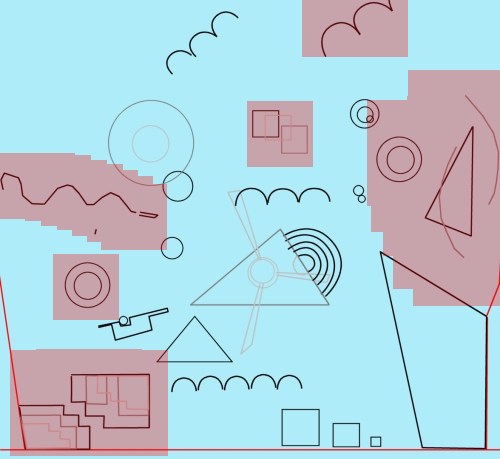
The areas highlighted in red are the examples I'll be focusing on.
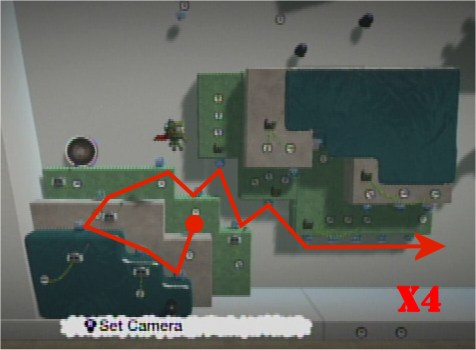
- This is the beginning of the level. Though it looks simple, and the platforming isn't challenging, chaining all of the points presents quite a challenging puzzle. To chain all 15 points, players must understand the shape well and how the 3D layering can help or hinder their progression. The red line represents the path I've found that gets the job done.
- With additional players, this whole area can be skipped and returned to from the top to take advantage of the points inside the "cave" and connected to the tan shapes at the top right.
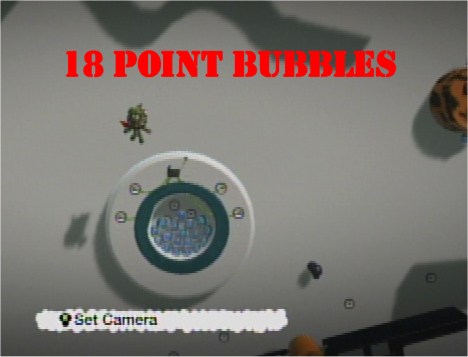
- This is one of the hardest to reach areas in the level. To reward players for making it here, I've tucked away 18 point bubbles inside. I designed this area so that it doesn't chain easily creating a chain stop. The point is to find a way here, and the reward is a determined amount of points. By making the reward significant, preventing this area from easily being chained keeps the over all points balanced.
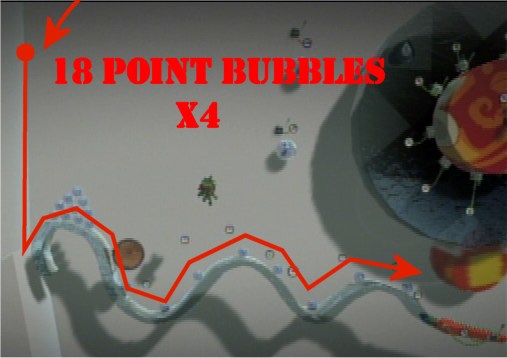
- In this area, players can chain the 8 point bubbles by running along the glass from right to left. However, the incline is too steep on the left most hill for players to climb. In order to chain this entire section, players must find a way to travel up and over this area to the left wall similar to the strategy exhibited in the Donkey Kong Jungle Beat video. By dropping down, players can easily access the 10 points at the top of the hill, and then slide down moving to the right to chain all 18 points.
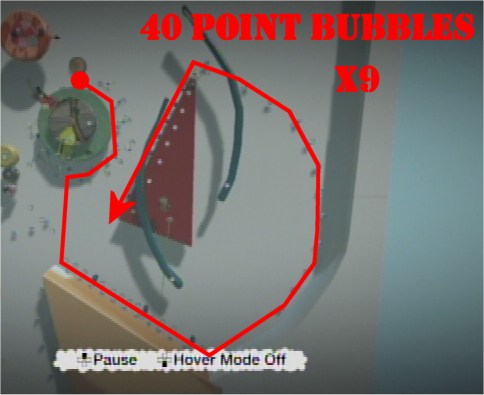
- This section is designed with a complex chain path. By dropping down onto the yellow ramp, players have to be careful to control their speed so that the red triangle is waiting for them when they get to the end. Otherwise, the chain timer will run out. By holding on to the tip at the end of the red triangle ride, players can swing around to the left side of the triangle and slide down to collect all 40 points.
- With two players, it's possible for one person to stall along the left side of the red triangle by repeatedly grabbing while the other travels to some other part of the level to chain additional points. The potential is wide open.
Ultimately, if you don't design every element of your level, including points, to work for the functional good of your level... then what's the point?